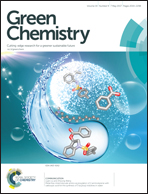Facile and sustainable synthesis of nitrogen-doped polymer and carbon porous spheres†
Abstract
The development of green, sustainable and simple synthetic pathways for the design of polymer and carbonaceous materials with well controlled features is of great importance in various fields of applications. Herein, we report a green synthetic method for polymer and carbon particles with well-defined shapes and sizes. This approach involves the use of green precursors, water as the solvent, and no templates under ambient temperature and pressure conditions, simultaneously. Green polymer resins (phloroglucinol-glyoxylic acid) and a catalyst/nitrogen source (triethylenediamine) are dissolved in water at room temperature resulting in polymer particles, which by subsequent thermal treatment transform into carbon particles. Mainly spherical carbon particles with controlled sizes from 500 nm to 10 μm are obtained by simply adjusting the experimental conditions, i.e., the synthesis time and molar ratio between the precursors or solvent. In some conditions, a flower-like morphology is obtained as well. The synthetic mechanism for the formation of the polymer resin spheres up to their conversion into carbon spheres is proposed based on several techniques, i.e., 13C NMR spectroscopy, SEM, XPS and TPD-MS (temperature programmed desorption coupled with mass spectrometry).



 Please wait while we load your content...
Please wait while we load your content...